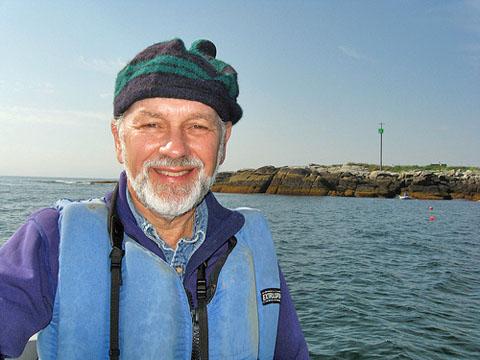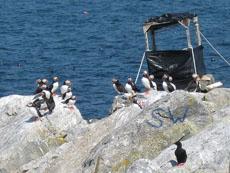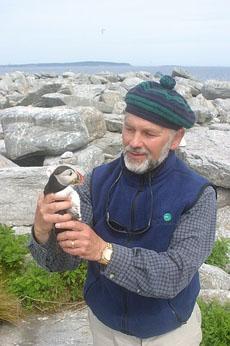 |
|
In 1973, as a young birding instructor in Maine, Kress began transplanting hundreds of downy puffin chicks from Newfoundland to Eastern Egg Rock, and later on to several other Maine islands. |
Starting point
Every summer, Kress gets on a boat with Project Puffinvolunteers and interns, and returns to where it all started: a tiny, treeless island called Eastern Egg Rock. A half hour out from the Maine coast, the island's craggy silhouette emerges from the sea spray.
 |
|
Today, 109 puffin pairs waddle about peaceably on Eastern Egg Rock, Maine. |
Kress says there are 7,000 nesting seabirds on the three-hectare island. When he slows the boat to moor it, a little black-and-white bird with a large bill splashed with orange flutters by. It looks like a shorter, chubbier version of a penguin.
"There's our first puffin just flew by -- that little white belly bird, very rapid wing beat," says Kress. "That's a puffin."
The seabirds are common across the North Atlantic. But for 300 years, settlers in Maine hunted puffins for their feathers, meat and eggs. By the early 1900's, there was only one pair of puffins left south of the Canadian border.
Transplant
In 1973, as a young birding instructor in Maine, Kress began transplanting hundreds of downy puffin chicks from Newfoundland to Eastern Egg Rock, and later on to several other Maine islands.
Today, a record 109 puffin pairs waddle about peaceably on Eastern Egg Rock, living amid terns and laughing gulls, whose shrieks pierce the sky.
 |
|
It took eight years from the time Stephen Kress moved the first first puffin chicks to Eastern Egg Rock until the first nesting pair appeared in 1981. |
Kress hops out of the boat and heads for a meter-square plywood bird blind to observe dozens of puffins resting on a granite boulder. Puffins raise their chicks inside the cracks of boulders like this. Some of Project Puffin's original chicks, who wear identification bands on their legs, come back every year.
"Y-33, who breeds just over that hill over there, that bird I had in the back of my car brought from Newfoundland in 1977," says Kress. "And so obviously that bird I'm particularly fond of. She's a little female that has lived in the same crevice her whole life. She's 33 years old now."
Kress lured Y-33 and other puffins back to the islands to nest as adults through pioneering social attraction techniques, which included deploying wooden decoy puffins and mirrors.
"They get tired of the decoys after a while. They try to rub beaks but they would eventually leave. And I came up with this idea of sort of an animated decoy by using the mirror," Kress explains. "Then they see their own face, and their own movement. And the idea was if they walk away they would be attracted back to their reflection. The idea was to try to keep them long enough so a second puffin would show up. And they would hopefully find a mate there."
Kress waited and waited for the techniques to work.
"It took eight years from the time we moved our first puffin chicks to the first time we had a nesting pair on the fourth of July in 1981."
Project Puffin
Kress doesn't have to relocate puffin chicks to Maine anymore, or use mirrors or decoys. But he's always thinking of new ways to protect puffins and other rare birds that have made Eastern Egg Rock their home.
He counts on Project Puffin's college interns and volunteers, who live on the island in the summer.
Island supervisor and graduate student Juliet Lamb walks through the fields of tall grasses, where some of the seabirds lay their eggs. She's on alert for birds that will be dive-bombing to protect their nests.
For the last three summers, Lamb has been arriving on the island in May to discourage the larger species of gulls that prey on puffins from breeding there. Lamb sees this intervention as leveling the playing field for the prey birds.
"Our responsibility as biologists is to start restoring some of the stuff that we've destroyed as a human population," says Lamb.
Interns will sometimes shoot especially aggressive gulls, but a more common strategy for keeping predators in check is to destroy the eggs of laughing gulls.
They are a particular threat to the terns that have also returned to Eastern Egg Rock, because they share breeding habitat. Each summer, the interns go around poking tiny holes in hundreds of eggs.
Michael Forsyth, a college student from Georgia, says by piercing the brown speckled eggs, but keeping them whole, the female laughing gulls might continue to sit on them, instead of laying new ones.
"You know it's hard because the laughing gulls are amazing birds in their own right," says Forsyth. "I feel like it's a real balancing act between all the different birds that come here and the management of every species."
That's a lesson Stephen Kress has taught his interns, and conservationists around the world.
Back at camp, Kress says restoring the puffin colony has meant making a lot of hard decisions. But the way he sees it, Eastern Egg Rock is the puffins' ancestral home and they deserve to be here.
"This is a very special place because it is the first restored seabird colony in the world. An important message to take that with it is that people brought the bird back and people are going to have to be here in the long-term to make sure that they stay here."
craggy:陡峭的;崎嶇的;多巖石的
flutter: flap, wave(拍翅膀)
decoy: lure, bait(用于誘捕鳥獸的誘餌)
prey on: 捕食
(來(lái)源:VOA 編輯:蔡姍姍)
